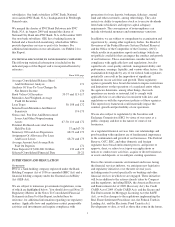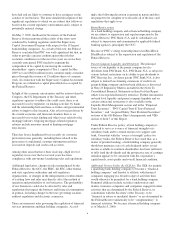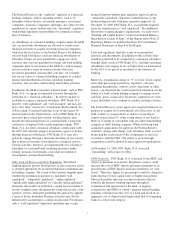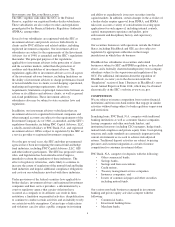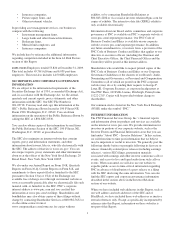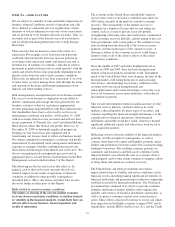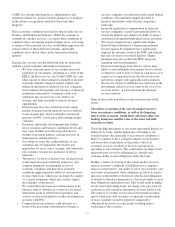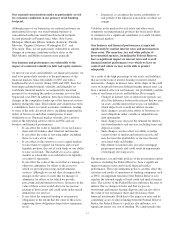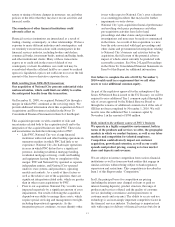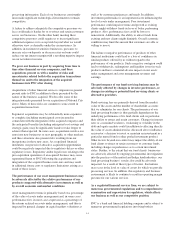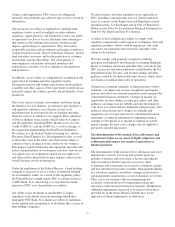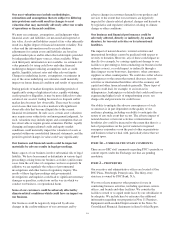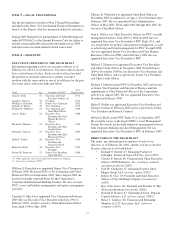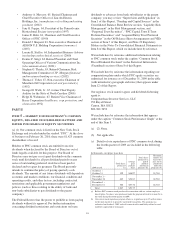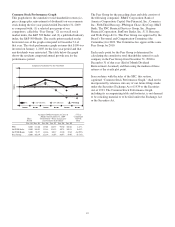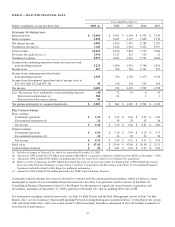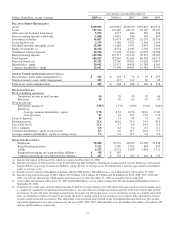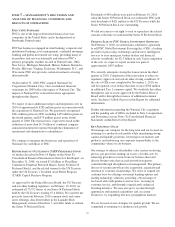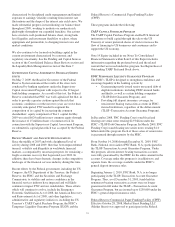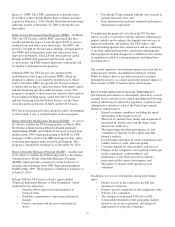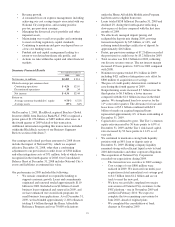PNC Bank 2009 Annual Report Download - page 19
Download and view the complete annual report
Please find page 19 of the 2009 PNC Bank annual report below. You can navigate through the pages in the report by either clicking on the pages listed below, or by using the keyword search tool below to find specific information within the annual report.business and organization. PNC services its obligations
primarily with dividends and advances that it receives from its
subsidiaries.
Our businesses are subject to regulation by multiple bank
regulatory bodies as well as multiple securities industry
regulators. Applicable laws and regulations restrict our ability
to repurchase stock or to receive dividends from subsidiaries
that operate in the banking and securities businesses and
impose capital adequacy requirements. They also restrict
permissible activities and investments and require compliance
with protections for loan, deposit, brokerage, fiduciary, mutual
fund and other customers, and for the protection of customer
information, among other things. The consequences of
noncompliance can include substantial monetary and
nonmonetary sanctions as well as damage to our reputation
and businesses.
In addition, we are subject to comprehensive examination and
supervision by banking and other regulatory bodies.
Examination reports and ratings (which often are not publicly
available) and other aspects of this supervisory framework can
materially impact the conduct, growth, and profitability of our
businesses.
Due to the current economic environment and issues facing
the financial services industry, we anticipate new legislative
and regulatory initiatives over the next several years,
including many focused specifically on banking and other
financial services in which we are engaged. These initiatives
will be in addition to the actions already taken by Congress
and the regulators, including EESA, the Recovery Act, the
Credit CARD Act, and the SAFE Act, as well as changes to
the regulations implementing the Real Estate Settlement
Procedures Act, the Federal Truth in Lending Act, and the
Electronic Fund Transfer Act. Developments to date, as well
as those that come in the future, have had and are likely to
continue to have an impact on the conduct of our business.
This impact could include rules and regulations that affect the
nature and profitability of our business activities, how we use
our capital, how we compensate and incent our employees,
and other matters potentially having a negative effect on our
overall business results and prospects.
Under the regulations of the Federal Reserve, a bank holding
company is expected to act as a source of financial strength
for its subsidiary banks. As a result of this regulatory policy,
the Federal Reserve might require PNC to commit resources
to PNC Bank, N.A. when doing so is not otherwise in the
interests of PNC or its shareholders or creditors.
Our ability to pay dividends to shareholders is largely
dependent on dividends from our operating subsidiaries,
principally PNC Bank, N.A. Banks are subject to regulation
on the amount and circumstances of dividends they can pay to
their holding companies.
We discuss these and other regulatory issues applicable to
PNC, including some particular areas of current regulatory
focus or concern, in the Supervision and Regulation section
included in Item 1 of this Report and in Note 23 Regulatory
Matters in the Notes To Consolidated Financial Statements in
Item 8 of this Report and here by reference.
A failure to have adequate procedures to comply with
regulatory requirements could expose us to damages, fines and
regulatory penalties, which could be significant, and could
also injure our reputation with customers and others with
whom we do business.
We must comply with generally accepted accounting
principles established by the Financial Accounting Standards
Board, accounting, disclosure and other rules set forth by the
SEC, income tax and other regulations established by the US
Department of the Treasury, and revenue rulings and other
guidance issued by the Internal Revenue Service, which affect
our financial condition and results of operations.
Changes in accounting standards, or interpretations of those
standards, can impact our revenue recognition and expense
policies and affect our estimation methods used to prepare the
consolidated financial statements. Changes in income tax
regulations, revenue rulings, revenue procedures, and other
guidance can impact our tax liability and alter the timing of
cash flows associated with tax deductions and payments. New
guidance often dictates how changes to standards and
regulations are to be presented in our consolidated financial
statements, as either an adjustment to beginning retained
earnings for the period or as income or expense in current
period earnings. In some cases, changes may be applied to
previously reported disclosures.
The determination of the amount of loss allowances and
impairments taken on our assets is highly subjective and
could materially impact our results of operations or
financial position.
The determination of the amount of loss allowances and asset
impairments varies by asset type and is based upon our
periodic evaluation and assessment of known and inherent
risks associated with the respective asset class. Such
evaluations and assessments are revised as conditions change
and new information becomes available. Management updates
its evaluations regularly and reflects changes in allowances
and impairments in operations as such evaluations are revised.
There can be no assurance that our management has
accurately assessed the level of impairments taken and
allowances reflected in our financial statements. Furthermore,
additional impairments may need to be taken or allowances
provided for in the future. Historical trends may not be
indicative of future impairments or allowances.
15


